Karl Shuker's Blog, page 50
November 29, 2013
FROM KING CHEETAHS TO KOOLOOKAMBAS - VOLUME 2 OF THE JOURNAL OF CRYPTOZOOLOGY IS NOW AVAILABLE TO PRE-ORDER
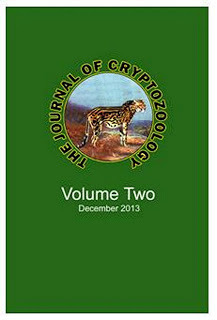
The orang pendek of Sumatra in Indonesia's Greater Sundas island group has attracted considerable cryptozoological attention, but could there also be diminutive yet previously less-publicised man-beasts existing still-undiscovered by science on Indonesia's much smaller Lesser Sundas island of Flores?
Does an ornate 16th-century painting from India's Mughal Empire hold the key to the former existence in Asia of a mystery cat analogous to Africa's king cheetah?
How can the vast diversity of reports appertaining to mysterious freshwater cryptids across the length and breadth of Spain be explained?
What is the taxonomic identity of the koolookamba, a longstanding African mystery ape known not only from reports but also from captive specimens - just an aberrant version of chimpanzee, or a taxonomically discrete form in its own right, or even a bona fide chimpanzee-gorilla hybrid?
These are the fascinating subjects and thought-provoking questions under consideration in the papers contained within Volume 2 of the Journal of Cryptozoology - the world's only peer-reviewed scientific periodical devoted to mystery animals - which is now available to pre-order here . Don't miss it!
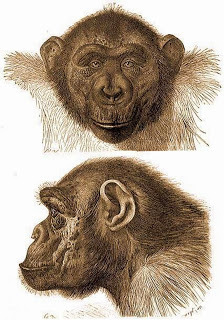 Engravings from 1896 of Mafuca, the most famous koolookamba to have been exhibited in captivity
Engravings from 1896 of Mafuca, the most famous koolookamba to have been exhibited in captivity
Published on November 29, 2013 08:40
November 24, 2013
MY NEW DRAGONS BOOK IS NOW AVAILABLE ON AMAZON!
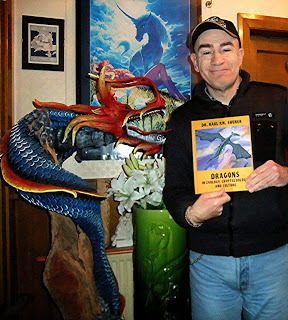
I'm delighted to announce that my latest book, Dragons in Zoology, Cryptozoology, and Culture (Coachwhip Publications: Greenville, 2013), is now available in hardback on both the USA Amazon site (click here ) and the UK Amazon site (click here ).
And here is what you'll find in it:
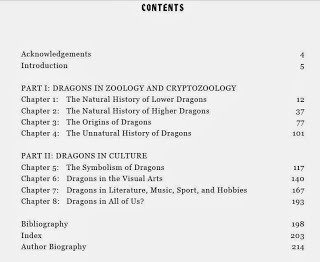
Enough to keep even the most devoted draconophile spellbound for hours!
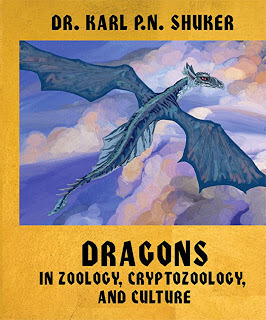
Published on November 24, 2013 14:05
November 22, 2013
FAREWELL, LITTLE SNOWFLAKE - TEN YEARS ON, MY TRIBUTE TO A UNIQUE ICON: THE WORLD'S ONLY WHITE GORILLA
st1\:*{behavior:url(#ieooui) }
 Little Snowflake as an adult
Little Snowflake as an adultHe was claimed to be the most photographed animal of all time (even appearing on the front cover of dance music duo Basement Jaxx's album Rooty), and he was indisputably one of the animal kingdom's greatest, most readily recognisable icons. He died 10 years ago this week, so here (first published in Fortean Times shortly after he died, but now expanded and updated in ShukerNature) is my tribute to Little Snowflake - the world's only known white gorilla.
As any cryptozoologist will confirm, Africa has always been replete with legends of bizarre-sounding beasts - some of which, notwithstanding, have ultimately proven to be real animals hitherto undescribed by science, as with the okapi, giant forest hog, and pygmy hippopotamus. Far more unlikely even than these, however, must surely be various ancient native legends of huge ghostly gorillas with pure-white fur worshipped as jungle deities. After all, none of these pallid entities had ever been spied by western explorers, so science scoffed at the mere notion of a white gorilla. Conversely, fiction writers and film makers alike were captivated by this semi-supernatural image, which duly featured in various adventure novels and movies.
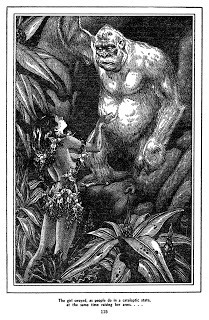 A Virgil Finlay illustration from 1949 for The White Gorilla by Elmer B Mason
A Virgil Finlay illustration from 1949 for The White Gorilla by Elmer B MasonAn early example, published in 1915, was written by Elmer B. Mason and succinctly entitled The White Gorilla.
A USAmovie of the same title directed by Harry L. Fraser was released in 1945, and starred stuntman Ray "Crash" Corrigan as an embittered African explorer determined to track down and kill the elusive but ferocious white ape that had previously savaged him.
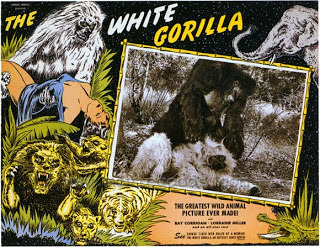 'The White Gorilla', starring Ray "Crash" Corrigan
'The White Gorilla', starring Ray "Crash" CorriganReturning to novels: another one, originally published in French in 1957, was entitled Le Gorille Blancand was penned by famous French science-fiction author Henri Vernes.
In 1966, it was republished in English as The White Gorilla, but by an incredible coincidence this very same year ended with an astonishing, totally unexpected discovery that effortlessly transcended and supplanted romantic fiction with truly remarkable fact.
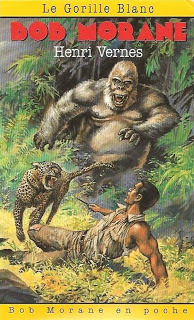 Le Gorille Blanc
by Henri Vernes
Le Gorille Blanc
by Henri VernesOn 1 October 1966, amid the dense jungle of the tiny West African country of Rio Muni (a former Spanish colony now part of Equatorial Guinea), an adult female lowland gorilla was shot while devouring bananas within the grove of local farmer Benito Mañé. When warily inspected afterwards, the gorilla was found to be dead, but clinging to her body, its head buried within her deep fur, was a tiny baby gorilla that was still alive. Moreover, as Mañé and the other villagers crowding near to view the corpse and its attached baby could clearly see, this was no ordinary gorilla infant. Mañé's description of it was as accurate as it was concise: 'Nfumu! Ngi! - 'White! Gorilla!'.
And indeed it was, covered entirely in snowy-white fur. It was not a full, complete albino, however, because its eyes were not pink but bright blue - thus corresponding with the condition exhibited by the white tigers of Rewa and the Timbavati white lions. News of this amazing discovery soon reached Dr Paul Zahl of the National Geographic Society's Natural Sciences Division, by way of Spanish naturalist Dr Jorge Sabater Pi, who had meanwhile purchased the little gorilla - a two-year-old male - from Mañé for £50. Sabater subsequently spent some time taming the young ape during its sojourn at the Centro de Adaptacion y Experimentacion de Ikunde, sited in Rio Munibut owned by Barcelona Zoo.
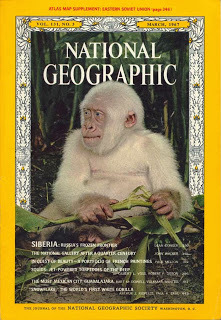 Little Snowflake debuting in National Geographic Magazine, March 1967
Little Snowflake debuting in National Geographic Magazine, March 1967Officially christened Nfumu, this white wonder was soon nicknamed Copito de Nieve - Spanish for 'Little Snowflake' - by Barcelona Zoo's director, Dr Antonio Jonch Cuspinera upon its arrival at Barcelona Zoo. And even though this name inevitably became somewhat incongruous when applied to what eventually became a fully-grown gorilla weighing around 400 lb, standing almost 6 ft tall, and sporting an 8-ft armspan, this is how the people of Barcelona - and far beyond - have popularly referred to their zoo's most famous inhabitant ever since. Little Snowflake he began, and Little Snowflake he remained.
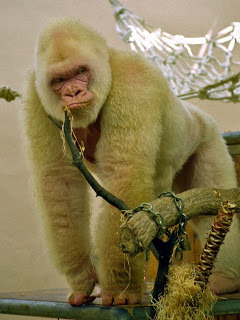 Little Snowflake, full-grown (Ettore Balocchi/Flickr/Wikipedia)
Little Snowflake, full-grown (Ettore Balocchi/Flickr/Wikipedia)Although records exist of gorillas with patches of white pigmentation that eventually disappeared, no other confirmed record of a pure-white gorilla is known, The closest item that I have been able to uncover is a snippet from Lawrence G. Green's Great African Mysteries(1937), in which he states:
"In the Upper Tano district of the Gold Coast Colony [now Ghana] a persistent native rumour of a 'wild man of the trees' was investigated some years ago. The natives dreaded the raids of this creature - described as a white giant. He killed children and sometimes carried off a woman over his shoulder. A white hunter set out to solve the mystery, and nearly lost his life in the attempt. He came face to face with the gorilla - a white-haired specimen - and failed to kill with the first shot. Then the gorilla was on him with a roar, breaking both his arms. Weakened by the wound, the gorilla crept away soon afterwards and the hunter survived."
This account seems highly sensationalised, and even if genuine it may simply be that the gorilla was an old individual whose dark hair had become silvered all over, an extreme example of the typical male silverback condition.
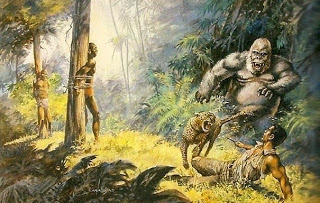 Painting of a belligerent white gorilla in the wild (image source unknown to me)
Painting of a belligerent white gorilla in the wild (image source unknown to me)As for Little Snowflake, his origin was a complete mystery. Although legends of white gorillas have emerged elsewhere in Africa, ironically there are no such myths prevalent in or around Equatorial Guinea, for the local villagers were just as astounded by his discovery as the scientists. Moreover, with no indication of any previous white gorillas in the area from which he could have inherited the two copies of the recessive mutant allele (gene form) needed to produce his pallid colouring, for many years scientists assumed that it may well have arisen via a spontaneous mutation, thus originating with Little Snowflake and lacking any genetic precursor (but see Postscript at the end of this ShukerNature post for new findings relating to the genetics responsible).
Consequently, zoologists at Barcelona Zoo hoped that by breeding Little Snowflake with normal gorillas at the zoo, the exceedingly rare recessive gene responsible for his unique appearance may be perpetuated, and that in the future other white gorillas may be born. As yet, however, this has not happened, but he was nothing if not obliging, having mated with three different female gorillas and sired no less than 22 offspring, all normal-coloured. Whereas in the wild his white fur would have made him dangerously conspicuous, in captivity Little Snowflake's dazzling pelage posed no problems for him - at least, not initially. However, he did suffer from a common complication associated with albinism - photophobia, a marked visual sensitivity to bright light.
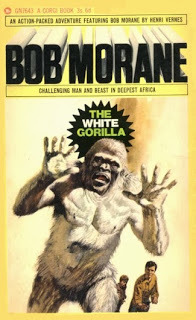 The White Gorilla
by Henri Vernes
The White Gorilla
by Henri VernesTragically, by 2001 he had developed another, much more serious condition that again may well have been due to his albinism - skin cancer. Little Snowflake, of course, lacked any melanin in his skin, the dark pigment that acts as a shield against the sun's harmful ultraviolet rays. For a time, he responded to treatment, but by late September 2003 zoo officials were sad to announce that his condition had progressed to a terminal state and that Little Snowflake, by now roughly 40 years old, had only a few months at most to live.
Faced with the shattering news that he was dying, thousands of Barcelona's people visited Little Snowflake each day, paying their respects to one of their city's greatest stars and symbols. And in the early hours of 24 November 2003, Little Snowflake quite literally melted away, euthanised peacefully while asleep by the zoo's vets to spare him any further suffering. Farewell, Little Snowflake. The world will be a duller place without your unique glory, but your essence lives on in each of your many offspring, and one day the great genetic lottery may create more white gorillas in your image, to astonish and enchant all over again (but, hopefully, without resulting in skin cancer).
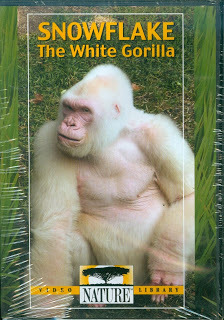 A 2005 DVD by Nature documenting the life and times of Little Snowflake
A 2005 DVD by Nature documenting the life and times of Little SnowflakePOSTCRIPT:In June 2013, after sequencing Little Snowflake's genome during the previous year from a sample of frozen blood taken before he died, a team of Spanish researchers (led by Tomas Marques-Bonet from the University of Pompeu Fabra) announced that their results indicated he was very inbred, because his parents shared 12% of their genome, suggesting that they may well have been uncle and niece. This inbred condition may in turn have caused the mutant allele responsible for his white colouration (now known to be the allele SLC45A2) to have surfaced.
 White gorilla illustration by Herge
White gorilla illustration by Herge And finally: more xenobiology than cryptozoology, and apes in name only, but wonderful all the same - here are the white apes of Barsoom as featured in the excellent 2012 Disney movie 'John Carter', which I thoroughly enjoyed when watching it last Christmas, and which was based upon A Princess of Mars - the first book in the Barsoom series of novels by Edgar Rice Burroughs.
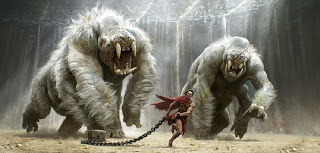 John Carter vs the white apes of Barsoom ((c) Walt Disney Studios Motion Pictures)
John Carter vs the white apes of Barsoom ((c) Walt Disney Studios Motion Pictures)
Published on November 22, 2013 12:19
November 19, 2013
THE IRAQI AFA - A MIDDLE EASTERN MYSTERY LIZARD
st1\:*{behavior:url(#ieooui) }
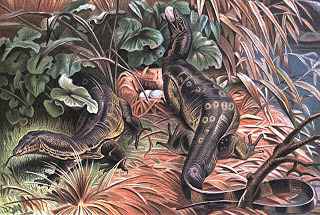 Salvator water monitors - could the afa be an unknown giant relative?
Salvator water monitors - could the afa be an unknown giant relative?One of the world's most obscure cryptozoological reptiles is the afa - a Middle Eastern mystery lizard briefly reported by explorer Sir Wilfred Thesiger in his book The Marsh Arabs (1964).
Also known as the Madan, the Marsh Arabs inhabited the marshlands of the Tigris and Euphrates rivers in the south and east of Iraq, and along the Iranian border – formerly a vast area of wetland covering more than 5.8 square miles. According to Thesiger, who had lived among them intermittently for eight years during the 1950s prior to the Iraqi revolution of 1958, the canoe-borne Madan claimed that the marshes at the mouth of the Tigris in Iraq was home to a monstrous lizard, which they termed the afa.
 Marsh Arabs in southern Iraq's marshlands - the abode of the afa
Marsh Arabs in southern Iraq's marshlands - the abode of the afaLittle else appears to have been documented concerning it. As various species of varanid or monitor lizard are native to this region of Asia Minor, however, it is plausible that the afa may be one too, albeit bigger than those formally recognised by science here - and hence either an unknown giant species, or based upon sightings of extra-large specimens of some known species.
Sadly, however, the question of the afa's taxonomic identity may be nothing more than academic nowadays. This is because following the Gulf War in 1991, the Iraqi government initiated a major programme to divert the flow of the Tigris and Euphrates Rivers away from the marshes in retaliation for a failed Shia uprising among the Arabs living there. This not only eliminated the Madan's food sources, forcing them to move elsewhere, but also turned the marshes themselves into a desert.
Consequently, the afa may well have been exterminated, especially if it were primarily aquatic, as I am not aware of any post-1991 reports alluding to it. If any ShukerNature reader is aware of any such reports, however, I'd be very interested to receive details.
 The desert monitor lizard Varanus griseus, a common Iraqi varanid (Knockout Mouse/Wikipedia)
The desert monitor lizard Varanus griseus, a common Iraqi varanid (Knockout Mouse/Wikipedia)
Published on November 19, 2013 13:34
November 14, 2013
THE DRAGONS ARE COMING! - FIRST PREVIEW OF MY LATEST, 20TH BOOK
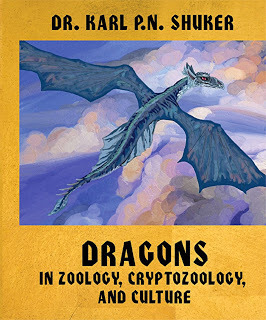
Hot on the heels of Mirabilis comes my latest, 20th book – Dragons in Zoology, Cryptozoology, and Culture , scheduled for publication next month by Coachwhip Publications (Greenville, Ohio), just in time for Christmas! Above is a sneak preview of its cover, which includes one of several spectacular examples of dragon artwork very kindly prepared specifically for it by extremely talented artist Thomas Finley – thanks, Thomas!
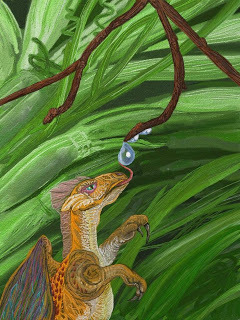
Whereas my first dragons book – Dragons: A Natural History (1995) - concentrated on retelling dragon myths in vibrant lyrical prose, this all-new, second dragons book is a 'facts and figures' non-fiction exploration of every aspect of dragons. So except for both of them being illustrated throughout in colour and b/w, the two books are totally different from one another (as opposed to the second merely being an update of the first, which is what some readers mistakenly assumed when first learning about it), and they collectively cover pretty well everything that I've ever wanted to write about dragons - just as my two books on mysterious and mythological cats ( Mystery Cats of the World , 1989; and Cats of Magic, Mythology, and Mystery , 2012) cover pretty well everything that I've ever wanted to write about such cats.
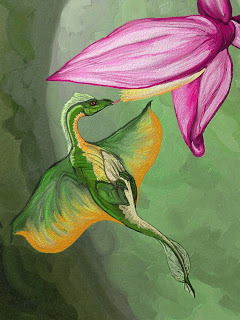
As soon as it is available on Amazon, I'll add a link here – so keep checking back! Meanwhile, enjoy the additional examples included here of Thomas Finley's beautiful dragon artwork ((c) Thomas Finley), excerpted from my book, which contains more than 170 illustrations in total (some by other celebrated artist friends of mine, such as Anthony Wallis, Richard Svensson, Rebekah Sisk, William Rebsamen, Andy Paciorek, Hodari Nundu, Tim Morris, Pat Burroughs, and Markus Bühler), including also the following pictures:
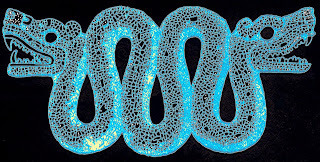 Xiuhcoatl, portrayed as a vertical Aztec amphisbaena ((c) Dr Karl Shuker)
Xiuhcoatl, portrayed as a vertical Aztec amphisbaena ((c) Dr Karl Shuker) Hand-coloured photograph of my mother, Mary D. Shuker, wearing a dragon-embroidered kimono during the mid-1940s ((c) Dr Karl Shuker)
Hand-coloured photograph of my mother, Mary D. Shuker, wearing a dragon-embroidered kimono during the mid-1940s ((c) Dr Karl Shuker)And finally...
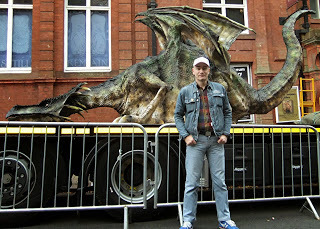 Posing alongside a reassuringly-subdued dragon! ((c) Dr Karl Shuker)
Posing alongside a reassuringly-subdued dragon! ((c) Dr Karl Shuker)
Published on November 14, 2013 13:32
November 5, 2013
BILBO BAGGINS VERSUS THE MONGOLIAN DEATH WORM?
/* Style Definitions */ table.MsoNormalTable {mso-style-name:"Table Normal"; mso-tstyle-rowband-size:0; mso-tstyle-colband-size:0; mso-style-noshow:yes; mso-style-parent:""; mso-padding-alt:0cm 5.4pt 0cm 5.4pt; mso-para-margin:0cm; mso-para-margin-bottom:.0001pt; mso-pagination:widow-orphan; font-size:10.0pt; font-family:"Times New Roman";}
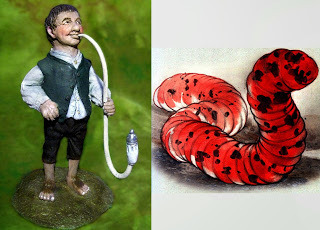 An unofficial, personal interpretation of the hobbit Bilbo Baggins (Richard Svensson) and a representation of the Mongolian death worm based upon eyewitness accounts (Ivan Mackerle)
An unofficial, personal interpretation of the hobbit Bilbo Baggins (Richard Svensson) and a representation of the Mongolian death worm based upon eyewitness accounts (Ivan Mackerle)
The works of J.R.R. Tolkien contain a number of creatures with some pertinence to cryptozoology, such as giant spiders, dragons, and the dreaded watcher in the water (a monstrous freshwater cephalopod?). Yet perhaps the most unexpected as well as the most fascinating Tolkien reference to a cryptid, which occurs in The Hobbit (1937), is so brief and inconspicuous that it can be easily passed by or even entirely overlooked, with its cryptozoological significance not even registering upon the reader. This is a great tragedy, because, remarkable as it may seem, the mystery beast in question is none other than the extraordinary Mongolian death worm!
 J.R.R. Tolkien, aged 24, photographed in 1916 when a soldier in the British Army during World War I (Public domain/Wikipedia)
J.R.R. Tolkien, aged 24, photographed in 1916 when a soldier in the British Army during World War I (Public domain/Wikipedia)
In 'An Unexpected Party', which is the opening chapter of The Hobbit, the hobbit in question, Bilbo Baggins, has received an unexpected visit at his home, Bag End, from the wizard Gandalf and a company of dwarves, whom Gandalf has informed would do well to include Bilbo, as a burglar, in their planned quest to retrieve their stolen gold from the great dragon Smaug. The dwarves, however, are far from convinced that Bilbo would be serve well in this capacity, and they air their doubts very vocally in Bilbo's parlour while he is in the drawing-room (but, unbeknownst to them, still within ear-shot of their protestations). Angered by their dismissive attitude, Bilbo strides back into the parlour, and boldly proclaims that he is more than capable of fulfilling the role that they wish him to undertake:
Tell me what you want done, and I will try it, if I have to walk from here to the East of East and fight the wild Were-worms in the Last Desert…
Brave words indeed, but also very puzzling ones, because they are never explained nor even referred to ever again either within this or any other Tolkien novel. They are presumably said by Bilbo in a figurative sense, to convey that he is willing to tackle anything. But even so, what exactly are the wild Were-worms that they refer to, and where was the Last Desert?
 An earthworm
An earthworm
The term 'worm' has a number of different zoological and zoomythological meanings. Its most familiar zoological meaning is as a contraction of 'earthworm' – the common name for most terrestrial oligochaetes. However, many other, unrelated zoological invertebrate taxa that include long, elongate species also have 'worm' in their names – tapeworms, peanut worms, acorn worms, beardworms, thorny-headed worms, ragworms, roundworms, flatworms, etc etc. There are even a few worm-dubbed vertebrates, such as the slow worm Anguis fragilis (a species of limbless lizard).
In zoomythology, 'worm' is one of several related terms – others include 'orm', 'ormer', and 'wyrm' – applied to certain serpent dragons (i.e. limbless, wingless dragons that basically resemble huge serpents except for their dragon-like head), such as Britain's Lambton worm, Linton worm, and Kellington worm. This category of dragon was also often characterised by noxious breath (rather than breathing fire), and the ability to rejoin into a single entity again if cut up into segments.
In Tolkien's works, conversely, he applies the term 'worm' to a very elongate-bodied form of classical dragon, i.e. equipped with four legs, a pair of wings, and the ability to breathe fire. Smaug in The Hobbit was a prime example of Tolkien's dracontological definition of 'worm'.
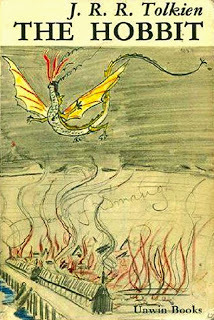 My trusty 40-year-old copy of The Hobbit, featuring an early sketch by Tolkien himself of the worm Smaug on its cover (illustration © Unwin Books)
My trusty 40-year-old copy of The Hobbit, featuring an early sketch by Tolkien himself of the worm Smaug on its cover (illustration © Unwin Books)
Consequently, the were-worm may be a bona fide type of invertebrate worm, albeit one of formidable size and/or temperament if it warranted being fought against (as opposed merely to being trodden upon!); or it could be a Smaug-like dragon. But what about the 'were' component of its name?
This prefix, from the Old English 'wer', generally denotes 'human' - hence a werewolf, for instance, is a human that can transform itself into a wolf, a weretiger is a human that can transform itself into a tiger, and so on. Does this mean, therefore, that a were-worm is a human that can transform itself either into a gigantic invertebrate-type worm or, perhaps more plausibly, into a dragon? Alternatively, is it a true invertebrate-type worm, or a true dragon, but one that exhibits highly advanced, human-like intelligence? Or could it even refer to a being that was half-human, half-dragon, akin in form perhaps to the ancient Indian snake deities or nagas, which possessed human heads (and sometimes thorax and arms too) but serpent bodies? Any of these solutions, however, would involve an entity of truly monstrous nature.
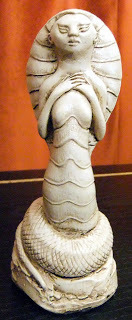 Figurine of a female naga, or nagini (Dr Karl Shuker)
Figurine of a female naga, or nagini (Dr Karl Shuker)
As for the Last Desert, where these were-worms reputedly dwell: all that appears to be known about this arid realm is that according to hobbit folklore, it is located at the very easternmost end of Middle-earth, and therefore lies far to the east of the Shire where the hobbits live.
But where does the Mongolian death worm fit into all of this? As any self-respecting cryptozoologist will know, this much-dreaded cryptid allegedly inhabits the Gobi Desert, and according to the nomads living in fear of it there, it can not only squirt a lethal acidic venom at anyone confronting it, but also kill directly via touch (or even indirectly if a person touches it with an implement made of metal) in a mysterious manner that is extraordinarily reminiscent of electrocution.
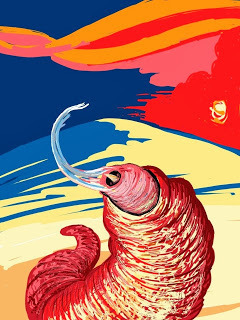 Another representation of the Mongolian death worm (Thomas Finley)
Another representation of the Mongolian death worm (Thomas Finley)
Yet even the versatile death worm cannot transform into a human or vice-versa. So what connection can there be between this cryptid and Tolkien's were-worm, other than that they both inhabit deserts?
A comprehensive two-volume study of The Hobbit, entitled The History of The Hobbit, Mr Baggins, was published in 2007 by HarperCollins in the UK (and by Houghton Mifflin in the USA), containing Tolkien's unpublished drafts of The Hobbit, together with commentary written by Tolkien scholar John D. Rateliff. These drafts revealed how this novel had undergone many changes, some minor, some major, between the very first version and the final, published edition. One such change is of paramount important to the subject of this ShukerNature post, because it concerns Bilbo's statement regarding the were-worms.
It turns out that in the very first, original draft of The Hobbit, that statement made no mention at all of were-worms, or of the Last Desert. Instead, what it did state, very thought-provokingly, is as follows:
[that Bilbo would walk to] the Great Desert of Gobi and fight the Wild Wire worms of the Chinese.
How remarkable that the Last Desert as named in the final, published edition of The Hobbit was clearly inspired, therefore, by none other than the real-life Gobi Desert. And no less significant is that the ostensibly shape-shifting were-worm was apparently no such thing in the original draft of The Hobbit, being a wire-worm instead. But what did this term signify?
 An Oriental dragon
An Oriental dragon
In view of the reference to the Chinese, could it have referred to one of those famously serpentine-bodied Oriental dragons? However, they tend to waft languorously through the skies, or rise up from the seas or from deep freshwater pools, rather than reside in deserts, and are often viewed in ancient Eastern traditions as deities. So this identity for Tolkien's wild wire worms seems somewhat unlikely. And why, in any case, would he have applied the adjective 'wire' to such dragons?
Certainly, the term 'wire worm' is intriguing, inasmuch as in zoological parlance a wire worm is the elongate limbless worm-like larva of a click beetle, belonging to the family Elateridae. But I hardly think that Tolkien was referring to some hobbit-inimical, hyper-aggressive click beetle grub when writing of 'Wild Wire worms'.
 Two species of click beetle and their respective wire worm larval form
Two species of click beetle and their respective wire worm larval form
All of which brings us, therefore, to the Mongolian death worm. This cryptozoological creature has definitely – indeed, exclusively – been reported from the Gobi Desert, and is undeniably zoologically worm-like in overall appearance (its local names, allergorhai-horhai and allghoi-khorkhoi, both translate as 'intestine worm', as it is likened by the nomads to a worm that resembles an animate intestine). But is it conceivable that Tolkien had heard of such an entity, especially way back in the 1930s? After all, Western cryptozoology itself did not become aware of it until the 1990s, when Czech explorer Ivan Mackerle began searching for and writing about the Gobi's reputed inhabitant after having researched its history in Russian and Mongolian documents.
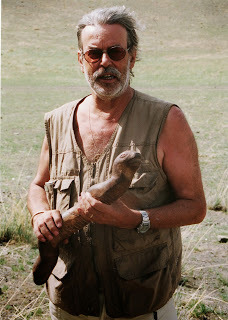 Wood carving of a death worm-like creature in Gobi museum near Dalanzadgad, Mongolia (Ivan Mackerle)
Wood carving of a death worm-like creature in Gobi museum near Dalanzadgad, Mongolia (Ivan Mackerle)
Nevertheless, Tolkien, as a highly erudite, eclectic reader, may indeed have known of such a beast, thanks to the publication in 1926 of On the Trail of Ancient Man, written by eminent American palaeontologist Prof. Roy Chapman Andrews. This bestselling book concerns the American Museum of Natural History's famous Central Asiatic Expedition of 1922 to the Gobi, led by Prof. Andrews, in search of dinosaur fossils, but it also includes a mention of the Mongolian death worm – which as far as I am aware is the earliest such mention of it in any Western publication.
In order to obtain the necessary permits for the expedition to venture forth into the Gobi, Andrews needed to meet the Mongolian Cabinet at the Foreign Office. When he arrived, he discovered that numerous officials were attending their meeting, including the Mongolian Premier. After Andrews had signed the required agreement in order to obtain the expedition's permits, the Premier made one final but very unusual and totally unexpected request:
Then the Premier asked that, if it were possible, I should capture for the Mongolian government a specimen of the allergorhai-horhai. I doubt whether any of my scientific readers can identify this animal. I could, because I had heard of it often. None of those present ever had seen the creature, but they all firmly believed in its existence and described it minutely. It is shaped like a sausage about two feet long, has no head nor legs and is so poisonous that merely to touch it means instant death. It lives in the most desolate parts of the Gobi Desert, whither we were going. To the Mongols it seems to be what the dragon is to the Chinese. The Premier said that, although he had never seen it himself, he knew a man who had and had lived to tell the tale. Then a Cabinet Minister stated that "the cousin of his late wife's sister" had also seen it. I promised to produce the allergorhai-horhai if we chanced to cross its path, and explained how it could be seized by means of long steel collecting forceps; moreover, I could wear dark glasses, so that the disastrous effects of even looking at so poisonous a creature would be neutralized. The meeting adjourned with the best of feeling.
Call me a cynic, but I have the distinct impression that Prof. Andrews did not take the death worm too seriously. In any event, he certainly didn't succeed in finding one, which is probably no bad thing - bearing in mind that he had planned to pick up with steel forceps a creature that had allegedly killed a fellow geologist who had prodded it with a metal rod!
 Prof. Roy Chapman Andrews (George Grantham Bain Collection/USA Library of Congress/Wikipedia)
Prof. Roy Chapman Andrews (George Grantham Bain Collection/USA Library of Congress/Wikipedia)
During the 1920s, the American Museum of Natural History sent forth several additional Central Asiatic Expeditions to Mongolia and China, and in 1932 a major work, The New Conquest of Central Asia, was published, documenting all of them, with Prof. Andrews as its principal author. The first volume in the series Natural History of Central Asia (edited by Dr Chester A. Reeds), it contained a brief section entitled 'The Allergorhai Horhai':
At the Cabinet meeting the Premier asked that I should capture for the Mongolian Government a specimen of the Allergorhai horhai. This is probably an entirely mythical animal, but it may have some little basis in fact, for every northern Mongol firmly believes in it and will give essentially the same description. It is said to be about two feet long, the body shaped like a sausage, and to have no head or legs; it is so poisonous that even to touch it means instant death. It is reported to live in the most arid, sandy regions of the western Gobi. What reptile can have furnished the basis for the description is a mystery!
I have never yet found a Mongol who was willing to admit that he had actually seen it himself, although dozens say they know men who have. Moreover, whenever we went to a region which was said to be a favorite habitat of the beast, the Mongols at that particular spot said that it could be found in abundance a few miles away. Were not the belief in its existence so firm and general, I would dismiss it as a myth. I report it here with the hope that future explorers of the Gobi may have better success than we had in running to earth the Allergorhai horhai.
If Tolkien had read either or both of these books, and as someone passionately interested in archaeology it is by no means an unlikely possibility, then he would indeed have learnt of the dreaded death worm, whose sensational nature might very well have impressed him sufficiently to incorporate a version of this creature in his first draft of The Hobbit. Moreover, Andrews's comparison of the death worm's significance to the Mongolian people with that of the dragon to the Chinese may even have inspired Tolkien's otherwise-opaque linking of the wild wire worms to the Chinese.
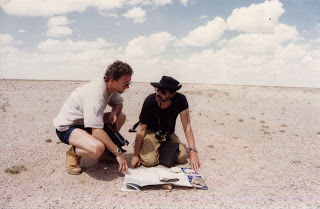 Dr Jarda Prokopec and Ivan Mackerle seeking the Mongolian death worm in the Gobi Desert (Ivan Mackerle)
Dr Jarda Prokopec and Ivan Mackerle seeking the Mongolian death worm in the Gobi Desert (Ivan Mackerle)
As for why the wild wire worms were replaced in later drafts by wild were-worms, and the Gobi Desert replaced by the Last Desert, who can say? Perhaps Tolkien felt that the latter versions were more compatible with the entirely fictitious Middle-earth than were a real desert and a semi(?)-mythical creature from Mongolian tradition referenced to in a real scientific publication.
Whatever the answer, that memorable sentence in Tolkien's original draft of The Hobbit remains a compelling enigma. And if nothing else, it conjures up the truly surreal scenario of a hobbit doing battle with the Mongolian death worm – which is surely worthy of a novel in its own right!
For the most comprehensive documentation of the Mongolian death worm ever published, see my book The Beasts That Hide From Man (Paraview: New York, 2003).
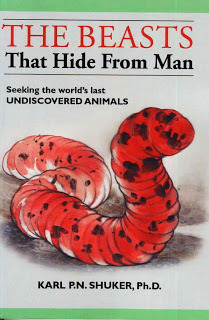
 An unofficial, personal interpretation of the hobbit Bilbo Baggins (Richard Svensson) and a representation of the Mongolian death worm based upon eyewitness accounts (Ivan Mackerle)
An unofficial, personal interpretation of the hobbit Bilbo Baggins (Richard Svensson) and a representation of the Mongolian death worm based upon eyewitness accounts (Ivan Mackerle)The works of J.R.R. Tolkien contain a number of creatures with some pertinence to cryptozoology, such as giant spiders, dragons, and the dreaded watcher in the water (a monstrous freshwater cephalopod?). Yet perhaps the most unexpected as well as the most fascinating Tolkien reference to a cryptid, which occurs in The Hobbit (1937), is so brief and inconspicuous that it can be easily passed by or even entirely overlooked, with its cryptozoological significance not even registering upon the reader. This is a great tragedy, because, remarkable as it may seem, the mystery beast in question is none other than the extraordinary Mongolian death worm!
 J.R.R. Tolkien, aged 24, photographed in 1916 when a soldier in the British Army during World War I (Public domain/Wikipedia)
J.R.R. Tolkien, aged 24, photographed in 1916 when a soldier in the British Army during World War I (Public domain/Wikipedia)In 'An Unexpected Party', which is the opening chapter of The Hobbit, the hobbit in question, Bilbo Baggins, has received an unexpected visit at his home, Bag End, from the wizard Gandalf and a company of dwarves, whom Gandalf has informed would do well to include Bilbo, as a burglar, in their planned quest to retrieve their stolen gold from the great dragon Smaug. The dwarves, however, are far from convinced that Bilbo would be serve well in this capacity, and they air their doubts very vocally in Bilbo's parlour while he is in the drawing-room (but, unbeknownst to them, still within ear-shot of their protestations). Angered by their dismissive attitude, Bilbo strides back into the parlour, and boldly proclaims that he is more than capable of fulfilling the role that they wish him to undertake:
Tell me what you want done, and I will try it, if I have to walk from here to the East of East and fight the wild Were-worms in the Last Desert…
Brave words indeed, but also very puzzling ones, because they are never explained nor even referred to ever again either within this or any other Tolkien novel. They are presumably said by Bilbo in a figurative sense, to convey that he is willing to tackle anything. But even so, what exactly are the wild Were-worms that they refer to, and where was the Last Desert?
 An earthworm
An earthwormThe term 'worm' has a number of different zoological and zoomythological meanings. Its most familiar zoological meaning is as a contraction of 'earthworm' – the common name for most terrestrial oligochaetes. However, many other, unrelated zoological invertebrate taxa that include long, elongate species also have 'worm' in their names – tapeworms, peanut worms, acorn worms, beardworms, thorny-headed worms, ragworms, roundworms, flatworms, etc etc. There are even a few worm-dubbed vertebrates, such as the slow worm Anguis fragilis (a species of limbless lizard).
In zoomythology, 'worm' is one of several related terms – others include 'orm', 'ormer', and 'wyrm' – applied to certain serpent dragons (i.e. limbless, wingless dragons that basically resemble huge serpents except for their dragon-like head), such as Britain's Lambton worm, Linton worm, and Kellington worm. This category of dragon was also often characterised by noxious breath (rather than breathing fire), and the ability to rejoin into a single entity again if cut up into segments.
In Tolkien's works, conversely, he applies the term 'worm' to a very elongate-bodied form of classical dragon, i.e. equipped with four legs, a pair of wings, and the ability to breathe fire. Smaug in The Hobbit was a prime example of Tolkien's dracontological definition of 'worm'.
 My trusty 40-year-old copy of The Hobbit, featuring an early sketch by Tolkien himself of the worm Smaug on its cover (illustration © Unwin Books)
My trusty 40-year-old copy of The Hobbit, featuring an early sketch by Tolkien himself of the worm Smaug on its cover (illustration © Unwin Books)Consequently, the were-worm may be a bona fide type of invertebrate worm, albeit one of formidable size and/or temperament if it warranted being fought against (as opposed merely to being trodden upon!); or it could be a Smaug-like dragon. But what about the 'were' component of its name?
This prefix, from the Old English 'wer', generally denotes 'human' - hence a werewolf, for instance, is a human that can transform itself into a wolf, a weretiger is a human that can transform itself into a tiger, and so on. Does this mean, therefore, that a were-worm is a human that can transform itself either into a gigantic invertebrate-type worm or, perhaps more plausibly, into a dragon? Alternatively, is it a true invertebrate-type worm, or a true dragon, but one that exhibits highly advanced, human-like intelligence? Or could it even refer to a being that was half-human, half-dragon, akin in form perhaps to the ancient Indian snake deities or nagas, which possessed human heads (and sometimes thorax and arms too) but serpent bodies? Any of these solutions, however, would involve an entity of truly monstrous nature.
 Figurine of a female naga, or nagini (Dr Karl Shuker)
Figurine of a female naga, or nagini (Dr Karl Shuker)As for the Last Desert, where these were-worms reputedly dwell: all that appears to be known about this arid realm is that according to hobbit folklore, it is located at the very easternmost end of Middle-earth, and therefore lies far to the east of the Shire where the hobbits live.
But where does the Mongolian death worm fit into all of this? As any self-respecting cryptozoologist will know, this much-dreaded cryptid allegedly inhabits the Gobi Desert, and according to the nomads living in fear of it there, it can not only squirt a lethal acidic venom at anyone confronting it, but also kill directly via touch (or even indirectly if a person touches it with an implement made of metal) in a mysterious manner that is extraordinarily reminiscent of electrocution.
 Another representation of the Mongolian death worm (Thomas Finley)
Another representation of the Mongolian death worm (Thomas Finley)Yet even the versatile death worm cannot transform into a human or vice-versa. So what connection can there be between this cryptid and Tolkien's were-worm, other than that they both inhabit deserts?
A comprehensive two-volume study of The Hobbit, entitled The History of The Hobbit, Mr Baggins, was published in 2007 by HarperCollins in the UK (and by Houghton Mifflin in the USA), containing Tolkien's unpublished drafts of The Hobbit, together with commentary written by Tolkien scholar John D. Rateliff. These drafts revealed how this novel had undergone many changes, some minor, some major, between the very first version and the final, published edition. One such change is of paramount important to the subject of this ShukerNature post, because it concerns Bilbo's statement regarding the were-worms.
It turns out that in the very first, original draft of The Hobbit, that statement made no mention at all of were-worms, or of the Last Desert. Instead, what it did state, very thought-provokingly, is as follows:
[that Bilbo would walk to] the Great Desert of Gobi and fight the Wild Wire worms of the Chinese.
How remarkable that the Last Desert as named in the final, published edition of The Hobbit was clearly inspired, therefore, by none other than the real-life Gobi Desert. And no less significant is that the ostensibly shape-shifting were-worm was apparently no such thing in the original draft of The Hobbit, being a wire-worm instead. But what did this term signify?
 An Oriental dragon
An Oriental dragonIn view of the reference to the Chinese, could it have referred to one of those famously serpentine-bodied Oriental dragons? However, they tend to waft languorously through the skies, or rise up from the seas or from deep freshwater pools, rather than reside in deserts, and are often viewed in ancient Eastern traditions as deities. So this identity for Tolkien's wild wire worms seems somewhat unlikely. And why, in any case, would he have applied the adjective 'wire' to such dragons?
Certainly, the term 'wire worm' is intriguing, inasmuch as in zoological parlance a wire worm is the elongate limbless worm-like larva of a click beetle, belonging to the family Elateridae. But I hardly think that Tolkien was referring to some hobbit-inimical, hyper-aggressive click beetle grub when writing of 'Wild Wire worms'.
 Two species of click beetle and their respective wire worm larval form
Two species of click beetle and their respective wire worm larval formAll of which brings us, therefore, to the Mongolian death worm. This cryptozoological creature has definitely – indeed, exclusively – been reported from the Gobi Desert, and is undeniably zoologically worm-like in overall appearance (its local names, allergorhai-horhai and allghoi-khorkhoi, both translate as 'intestine worm', as it is likened by the nomads to a worm that resembles an animate intestine). But is it conceivable that Tolkien had heard of such an entity, especially way back in the 1930s? After all, Western cryptozoology itself did not become aware of it until the 1990s, when Czech explorer Ivan Mackerle began searching for and writing about the Gobi's reputed inhabitant after having researched its history in Russian and Mongolian documents.
 Wood carving of a death worm-like creature in Gobi museum near Dalanzadgad, Mongolia (Ivan Mackerle)
Wood carving of a death worm-like creature in Gobi museum near Dalanzadgad, Mongolia (Ivan Mackerle)Nevertheless, Tolkien, as a highly erudite, eclectic reader, may indeed have known of such a beast, thanks to the publication in 1926 of On the Trail of Ancient Man, written by eminent American palaeontologist Prof. Roy Chapman Andrews. This bestselling book concerns the American Museum of Natural History's famous Central Asiatic Expedition of 1922 to the Gobi, led by Prof. Andrews, in search of dinosaur fossils, but it also includes a mention of the Mongolian death worm – which as far as I am aware is the earliest such mention of it in any Western publication.
In order to obtain the necessary permits for the expedition to venture forth into the Gobi, Andrews needed to meet the Mongolian Cabinet at the Foreign Office. When he arrived, he discovered that numerous officials were attending their meeting, including the Mongolian Premier. After Andrews had signed the required agreement in order to obtain the expedition's permits, the Premier made one final but very unusual and totally unexpected request:
Then the Premier asked that, if it were possible, I should capture for the Mongolian government a specimen of the allergorhai-horhai. I doubt whether any of my scientific readers can identify this animal. I could, because I had heard of it often. None of those present ever had seen the creature, but they all firmly believed in its existence and described it minutely. It is shaped like a sausage about two feet long, has no head nor legs and is so poisonous that merely to touch it means instant death. It lives in the most desolate parts of the Gobi Desert, whither we were going. To the Mongols it seems to be what the dragon is to the Chinese. The Premier said that, although he had never seen it himself, he knew a man who had and had lived to tell the tale. Then a Cabinet Minister stated that "the cousin of his late wife's sister" had also seen it. I promised to produce the allergorhai-horhai if we chanced to cross its path, and explained how it could be seized by means of long steel collecting forceps; moreover, I could wear dark glasses, so that the disastrous effects of even looking at so poisonous a creature would be neutralized. The meeting adjourned with the best of feeling.
Call me a cynic, but I have the distinct impression that Prof. Andrews did not take the death worm too seriously. In any event, he certainly didn't succeed in finding one, which is probably no bad thing - bearing in mind that he had planned to pick up with steel forceps a creature that had allegedly killed a fellow geologist who had prodded it with a metal rod!
 Prof. Roy Chapman Andrews (George Grantham Bain Collection/USA Library of Congress/Wikipedia)
Prof. Roy Chapman Andrews (George Grantham Bain Collection/USA Library of Congress/Wikipedia)During the 1920s, the American Museum of Natural History sent forth several additional Central Asiatic Expeditions to Mongolia and China, and in 1932 a major work, The New Conquest of Central Asia, was published, documenting all of them, with Prof. Andrews as its principal author. The first volume in the series Natural History of Central Asia (edited by Dr Chester A. Reeds), it contained a brief section entitled 'The Allergorhai Horhai':
At the Cabinet meeting the Premier asked that I should capture for the Mongolian Government a specimen of the Allergorhai horhai. This is probably an entirely mythical animal, but it may have some little basis in fact, for every northern Mongol firmly believes in it and will give essentially the same description. It is said to be about two feet long, the body shaped like a sausage, and to have no head or legs; it is so poisonous that even to touch it means instant death. It is reported to live in the most arid, sandy regions of the western Gobi. What reptile can have furnished the basis for the description is a mystery!
I have never yet found a Mongol who was willing to admit that he had actually seen it himself, although dozens say they know men who have. Moreover, whenever we went to a region which was said to be a favorite habitat of the beast, the Mongols at that particular spot said that it could be found in abundance a few miles away. Were not the belief in its existence so firm and general, I would dismiss it as a myth. I report it here with the hope that future explorers of the Gobi may have better success than we had in running to earth the Allergorhai horhai.
If Tolkien had read either or both of these books, and as someone passionately interested in archaeology it is by no means an unlikely possibility, then he would indeed have learnt of the dreaded death worm, whose sensational nature might very well have impressed him sufficiently to incorporate a version of this creature in his first draft of The Hobbit. Moreover, Andrews's comparison of the death worm's significance to the Mongolian people with that of the dragon to the Chinese may even have inspired Tolkien's otherwise-opaque linking of the wild wire worms to the Chinese.
 Dr Jarda Prokopec and Ivan Mackerle seeking the Mongolian death worm in the Gobi Desert (Ivan Mackerle)
Dr Jarda Prokopec and Ivan Mackerle seeking the Mongolian death worm in the Gobi Desert (Ivan Mackerle)As for why the wild wire worms were replaced in later drafts by wild were-worms, and the Gobi Desert replaced by the Last Desert, who can say? Perhaps Tolkien felt that the latter versions were more compatible with the entirely fictitious Middle-earth than were a real desert and a semi(?)-mythical creature from Mongolian tradition referenced to in a real scientific publication.
Whatever the answer, that memorable sentence in Tolkien's original draft of The Hobbit remains a compelling enigma. And if nothing else, it conjures up the truly surreal scenario of a hobbit doing battle with the Mongolian death worm – which is surely worthy of a novel in its own right!
For the most comprehensive documentation of the Mongolian death worm ever published, see my book The Beasts That Hide From Man (Paraview: New York, 2003).

Published on November 05, 2013 16:18
October 28, 2013
BONES OF THE THUNDER HORSE
 A magnificent model by Jeff Johnson of Brontotherium (=Megacerops) (© Jeff Johnson)
A magnificent model by Jeff Johnson of Brontotherium (=Megacerops) (© Jeff Johnson)One of the most spectacular beasts from Amerindian mythology must surely be a huge, terrifying creature known as the thunder horse. According to Sioux legends emanating from Nebraska and South Dakota, thunder is the sound produced by the impact of its hooves when it leaps down from the skies to the ground during violent storms, and while on Earth it also uses its hooves to slay bison. Needless to say, it would be tempting to postulate that this extraordinary story was inspired by eyewitness accounts of some mysterious living creature - accounts perhaps passed down verbally from one generation to another for many centuries and subjected to much elaboration and exaggeration, but nonetheless derived ultimately from original encounters with a modern-day animal. In fact, the true solution is very different.
The thunder horse legend actually arose from occasional discoveries by the Sioux Nation of huge fossilised bones - which usually came to light by being washed up out of the ground during heavy rainstorms. Unable to explain their origin, but aware of their appearances' coincidence with rain, the Sioux assumed that they were the earthbound remains of some immense, storm-engendered sky beast - and thus was the legend born.
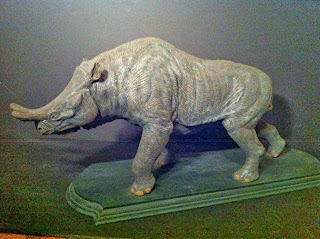 The Sioux thunder horse, aka Brontotherium (© Jeff Johnson)
The Sioux thunder horse, aka Brontotherium (© Jeff Johnson)In reality, the bones were from an enormous rhinoceros-like ungulate, standing 8 ft tall at the shoulder and belonging to an extinct family of horse-related perissodactyls aptly called titanotheres. The type responsible for the thunder horse legend had existed roughly 35 million years ago, during the late Eocene epoch, and it had borne upon its nasal bones a massive V-shaped projection most closely resembling the horn-like structures (ossicones) of the giraffes. When this creature's remains were examined during the 1870s by the celebrated American palaeontologist Prof. Othniel Charles Marsh, its intimately-associated thunder horse myth inspired him to christen it Brontotherium - 'thunder beast'.
NB - In recent years, the genus Brontotherium (along with several other brontothere genera of titanothere) has been synonymised with Megacerops by some researchers, but as far as its legendary past is concerned, this spectacular beast will always be the thunder horse – a monumental physical embodiment of the thunderstorm's awesome power and terror.
 Brontotherium
(© Jeff Johnson)
Brontotherium
(© Jeff Johnson)To read online a poem of mine, 'Behold The Thunder Horse', inspired by the Sioux Nation's thunder horse legend and contained in my self-penned poetry book Star Steeds and Other Dreams (2009), click here .
This ShukerNature post is excerpted and updated from my book In Search of Prehistoric Survivors (1995), which is to be re-issued in the not-too-distant future due to popular demand, so be sure to keep a lookout for it!
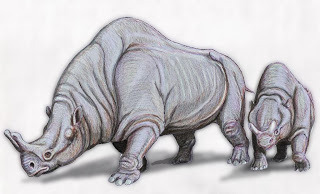 Restoration of a pair of Brontotherium titanotheres (Dmitry Bogdanov/Wikipedia)
Restoration of a pair of Brontotherium titanotheres (Dmitry Bogdanov/Wikipedia)
Published on October 28, 2013 13:52
October 27, 2013
MY VERY OWN CRYPTO-BIRD? - QUAILING AT THE POTENTIAL REDISCOVERY OF A LONG-LOST SPECIES
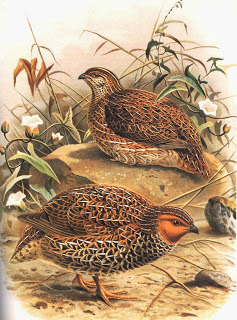 The New Zealand quail or koreke
The New Zealand quail or koreke In November 2006, I visited the island bird sanctuary of Tiritiri Matangi, off Auckland, New Zealand, home to some of this country’s rarest birds, including the famous takahe Porphyrio mantelli, the saddleback or tieke Philesturnus carunculatus, the North Island wattled crow or kokako Callaeas cinerea wilsoni, and the stitchbird Notiomystis cincta, all of which I was fortunate enough to espy in the wild state here. Walking back down from the island’s summit at the end of my visit, en route towards the ferry that would return me to Auckland, I noticed on the path up ahead two brown quail-like birds. They seemed rather large for Australian brown quails Coturnix ypsilophora, a non-native species that I knew had been introduced here long ago (as elsewhere in New Zealand), but they were otherwise similar and were definitely quails, as I readily confirmed with my binoculars before they scurried away into the undergrowth.
I thought no more of my sighting until May 2007. That was when I was startled to learn that this tiny island may still be home to a species hitherto thought to have become extinct everywhere as far back in time as 1875. And the species in question? The New Zealand quail or koreke Coturnix novaezealandiae. Larger than the Australian brown quail and once common throughout New Zealand, by 1840 the koreke had become much less so, due to habitat destruction for farming. By 1870, it had been exterminated on North Island, and by 1875 it had also disappeared on South Island, since when the koreke has been regarded as extinct.
 The Australian brown quail (Peripitus/Wikipedia)
The Australian brown quail (Peripitus/Wikipedia) In May 2007, however, I read a report stating that Massey University ornithological researcher Mark Seabrook-Davison had begun conducting DNA tests upon the quails on Tiritiri, because various researchers suspected that at least some of these birds might not be Australian quails at all, but may instead be surviving specimens of the koreke! If this were true, it meant that back in November 2006 I could well have seen an officially long-extinct, still formally undiscovered species.
Sadly, however, Seabrook-Davison's tests subsequently revealed that the Tiritiri birds, although indeed larger, were genetically identical to the Australian brown quail. So New Zealand’s own vanished species had not been resurrected after all. But for a few precious months, I had experienced the magic of what it must be like to encounter a cryptid. And in any case, I had also seen, at very close range, a celebrated former cryptid – the spectacular takahe. So my visit to Tiritiri Matangi was still a notable success for me, and will always remain one of my fondest memories of my travels around the globe.
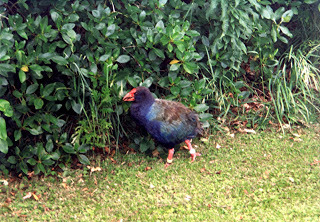 One of the takahes that I encountered on Tiritiri Matangi (Dr Karl Shuker)
One of the takahes that I encountered on Tiritiri Matangi (Dr Karl Shuker)
Published on October 27, 2013 15:52
October 24, 2013
HORNED HORSES AND HORSES WITH HORNS – DECIDEDLY DIFFERENT FROM HEAD TO TOE(S)
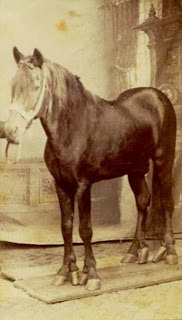 Photograph from c.1870 depicting a very spectacular horned horse
Photograph from c.1870 depicting a very spectacular horned horseHorned horses and horses with horns – they may sound anomalous (and indeed they are!), but such creatures are certainly one and the same thing, surely? Not at all – in fact, it is true in every sense to say that they are different from head to toe(s) !!
HORSES WITH HORNS
During the 19th Century, eminent French zoologist Baron Georges Cuvier loftily denounced that most mystical and magical of legendary beasts, the unicorn, as a zoological impossibility - claiming that a single median horn could never develop from the paired frontal (brow) bones of a mammal's skull. Since Cuvier's damning pronouncement, the unicorn has received short shrift from science. Yet this attitude may be both unjust and unjustified.
 The classical unicorn of equine form (Edward Topsell)
The classical unicorn of equine form (Edward Topsell)To begin with: in 1934, Maine University biologist Dr William Franklin Dove successfully, and spectacularly, refuted Cuvier's claim concerning the growth of a single median horn from the frontal bones - by creating a bovine unicorn. He achieved this remarkable feat by removing the embryonic horn buds from a day-old Ayrshire bull calf, trimming their edges flat, then transplanting them side by side onto the centre of the calf's brow. Growing in close contact with one another, the transplanted buds yielded a massive single horn, which proved so successful a weapon that its owner soon became the undisputed leader of an entire herd of cattle. Yet despite his dominance, this unicorn bull was a very placid beast, thus resembling the legendary unicorn not only morphologically but also behaviourally. Just a coincidence?
 Dr Dove's remarkable bovine unicorn (Dr William Franklin Dove)
Dr Dove's remarkable bovine unicorn (Dr William Franklin Dove)Some researchers have since speculated that perhaps ancient people knew of this simple technique, and had created single-horned herd leaders, whose imposing appearance and noble temperament thereafter became incorporated into the evolving unicorn legend.
Thus, the development of a single median horn is not an impossibility after all - at least not in cattle, that is. Horses, however, must surely be a very different matter, bearing in mind that they do not even grow paired horns (let alone median ones) - or do they?
In fact, records of horses with horns, though rare, are by no means unknown. In 1929, for instance, German zoologists P.P. Winogradow and A.L. Frolow published a short account within the journal Anatomische Anzeiger concerning a horse that had exhibited lateral horn development on its brow, accompanied by a photograph of the horse's skull.
Moreover, in an American Museum Novitates paper of 17 August 1934, S. Harmsted Chubb documented several horses each exhibiting a small pair of lateral skin-ensheathed frontal protuberances just above the eyes. In the photos of some such horses contained in Chubb's paper, however, these 'horns' can be seen to be tightly pressed against the side of the horse's skull, not projecting outward, away from the skull.
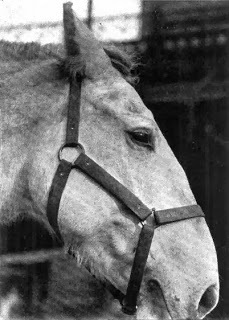 A work horse from Sheffield exhibiting a small pair of frontal protuberances, from Chubb's paper
A work horse from Sheffield exhibiting a small pair of frontal protuberances, from Chubb's paperFar more intriguing, conversely, is the following excerpt, from South American explorer Felix de Azara's Natural History of the Quadrupeds of Paraguay and the River La Plata (1837):
I have heard for a fact, that, a short time ago, a horse was born in Santa Fé de la Vera Cruz, which had two horns like a bull, four inches long, sharp and erect, growing close to the ears; and that another from Chili was brought to Don John Augustin Videla, a native of Buenos Ayres [sic], with strong horns, three inches high. This horse, they tell me, was remarkably gentle; but, when offended, he attacked like a bull. Videla sent the horse to some of his relatives in Mendoza, who gave it to an inhabitant of Cordova in Tucuman, who intended, as it was a stallion, to endeavour to form a race of horned horses. I am not aware of the results, which may probably have been favorable.
Thus, if horses can occasionally develop paired frontal horns and a median horn can be induced to grow from the frontal bones of cattle, then surely in this unrivalled age of biological modification, where sophisticated techniques yielding cloned, transgenic, and other man-made life forms are already commonplace, it would not be difficult to conduct a slightly modified version of Dove's experiments - using equine-derived horn (or horn-substitute) tissue, and a foal, instead of a calf, as the recipient?
Engineering a genuine equine unicorn would make a fascinating project for any zoological team capable of ignoring the sound of Cuvier turning loudly in his grave. After all, it isn't every day that science is granted the opportunity to create a living legend.
But if that is what constitutes a horse with horns, what, then, is a horned horse? I'm glad you asked!
HORNED HORSES
One of the most frequently reported and familiar of teratological conditions exhibited by humans is the possession of extra fingers and/or toes - polydactyly. However, this genetically-induced phenomenon has also been widely recorded among many domestic animals (e.g. dogs, cats, horses, pigs, chickens, pet rats and mice, guineapigs), as well as from wild species as diverse as bats, salamanders, leopards, llamas, and even the Malaysian flying lemur. Moreover, it can take several different forms, each under the control of a different mutant allele (gene form).
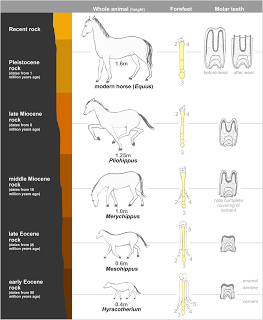 Representative sequence of evolutionary decrease in equine toe number (Mcy jerry/Wikipedia)
Representative sequence of evolutionary decrease in equine toe number (Mcy jerry/Wikipedia)Probably the most famous non-human examples of extra-toed mammals can be found among the records of polydactylous horses. One of the classic examples of evolution is the gradual disappearance over millions of years of all but one of the horse's functional toes. The horse lineage began with the Eocene epoch's 'dawn horse' Hyracotherium (formerly called Eohippus), with four functional toes on each forefoot; leading on to Mesohippus of the Oligocene epoch, with three toes; to Merychippus of the Miocene, in which the two lateral toes were greatly reduced in size so that they no longer touched the ground; and to Pliohippus of the Pliocene, whose two lateral toes were merely insignificant splints whereas its central toe was massively enlarged, with its single hoof (modified toenail) bearing the animal's entire body weight. This same condition is present in normal specimens of all modern-day horses too, belonging to the genus Equus. (It should be noted, however, that this is not a direct, straight-line evolutionary series, one genus leading directly to the next, even though it is commonly if erroneously presented as such, because several other genera of horses also appeared and disappeared during equine evolution, exhibiting varying numbers of toes.)
Nevertheless, the teratological literature contains numerous well-documented cases of abnormal modern-day horses (notably of the Shire horse breed) that possess one or more well-developed lateral toes, often bearing their own hooves and sometimes even touching the ground alongside the normal, massive central toe's hoof - as if determined to reverse the course of their own evolution!
One such horse was an extraordinary 19th-Century specimen from Texas, which possessed a pair of well-developed lateral toes on each hind foot, curving downwards on either side of the central one like horns - as a result of which this specimen became known as the horned horse. In contrast, only one such toe, positioned on the central toe's inner side, was present on each forefoot. It was from this specimen that other polydactylous horses also became known as horned horses, a term used in particular with specimens exhibited in sideshows, carnivals, circuses, etc.
 Line drawing of the original horned horse, from Texas
Line drawing of the original horned horse, from TexasThese very distinctive-looking horses have a long history, and include among their number a renowned steed of Julius Caesar. According to Suetonius in de Vita Caesaria (vol. LXVI):
[Caesar] used to ride a remarkable horse, which had feet that were almost human, the hoofs being cleft like toes. It was born in his own stables, and as the soothsayers declared that it showed the owner would be lord of the world, he reared it with great care, and was the first to mount it; it would allow no other rider.
This account and many others were included within a major paper on the subject by Prof. Othniel C. Marsh, published during April 1892 in the American Journal of Science. As Marsh noted, the extent of polydactyly exhibited by horses varies greatly. Some such specimens merely exhibit a small extra toe (often barely visible externally) on the inner side of one or both forefeet. In more notable cases, two such toes, one on each side of the normal central toe, may be present, plus one or a comparable pair on one or both hind feet (although these latter are usually smaller than their counterparts on the forefeet). In much rarer cases, however, these various supernumerary toes may be much more highly developed, to the extent that the affected feet compare favourably with the normal feet of the Miocene horse Merychippus, and even occasionally with the Oligocene's Mesohippus. Most dramatic of all are the extremely rare examples that not only mirror the Mesohippus condition but also possess a tiny fourth toe, representing the ancestral pollex (thumb) or hallux (big toe).
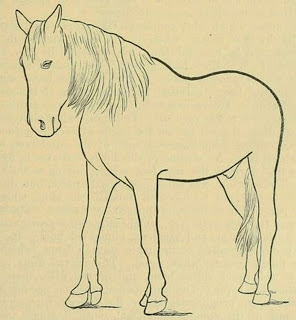 Line drawing of Clique
Line drawing of CliqueThe most celebrated example of this last-mentioned and very extreme equine polydactylous state is the so-called 'six-footed' horse owned by Theodore F. Wood of New Jersey and named Clique, who was exhibited at shows for many years in the U.S.A. and elsewhere. Clique died at an advanced age in January 1891, whereupon his owner presented his body to Prof. Marsh for the Yale Museum. Marsh observed that whereas his hind feet were basically normal, each of Clique's forefeet sported a well-developed toe on the central toe's inner side. For much of its length, this extra toe was separate from the central toe, bore its own long hoof, and actually made contact with the ground, so that each forefoot appeared double. This explained Clique's 'six-footed' appellation, because on first sight he seemed to possess two hind feet and four forefeet. In addition, close observations revealed that another supernumerary toe was represented by a splint-like structure on the outer side of the central toe on each of Clique's forefeet, whereas just under the skin in the locality of the ancestral pollex a similar splint could be felt that corresponded to a fourth toe!
Even more remarkable than Clique, however, though less famous, was a so-called 'eight-footed' Cuban horse depicted in Marsh's paper and reproduced below here in the present ShukerNature post, which gained its name from the fact that all four of its feet each bore a well-developed second toe on the inner side of the normal central toe, one again bearing its own hoof and making contact with the ground alongside the latter.
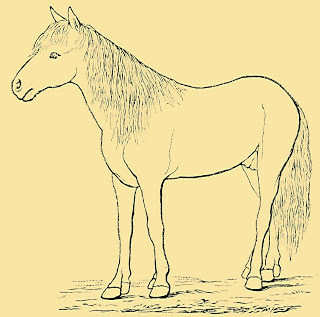 Line drawing of the 'eight-footed' Cuban horse examined by Prof. Othniel C. Marsh
Line drawing of the 'eight-footed' Cuban horse examined by Prof. Othniel C. MarshThis horse, a male, was on exhibition in New Orleans during spring 1878, and it was Dr Sanford E. Chaillé from that city who drew Prof. Marsh's attention to it. The horse was subsequently brought to the North, and a few days later was displayed at New Haven, Connecticut, where Marsh closely examined it.
As with the occasional reappearance of dew-claws on the hind feet of dogs, polydactyly in horses involves the redevelopment of toes normally absent in modern-day species but present in ancestral ones (rather than simply involving the duplication of existing toes, as occurring, for example, in polydactylous humans and cats). A plausible explanation for this type of polydactyly is that during the evolution of the horse, the genes responsible for the formation of all toes other than the central one became increasingly repressed by other genes, whereas those responsible for the central toe actually intensified their activity, so that eventually the latter was the only toe that was 'permitted' to form. Applying this theory to modern-day polydactylous horses, it could be argued that during their embryonic development something goes wrong with the repression mechanism acting upon the genes responsible for the formation of those ancestral toes, so that it fails to operate, with the result that these ostensibly 'lost' toes reappear - conjured forth as if by magic from their prehistoric past.
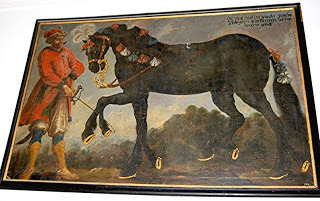 Painting of the supposed eight-footed horse owned by Mark Sittich von Hohenems, Prince-Archbishop of Salzburg (© Curious Expeditions/Flickr)
Painting of the supposed eight-footed horse owned by Mark Sittich von Hohenems, Prince-Archbishop of Salzburg (© Curious Expeditions/Flickr)According to a very beautiful colour painting portraying it (above), a bona fide eight-footed horse (i.e. one that possessed two entirely separate feet on each leg, not just supernumerary toes) was owned by Mark Sittich von Hohenems, Prince-Archbishop of Salzburg (1574-1619), who was renowed for his collection of rare and unusual animals. The horse had been obtained in Arabia, each of its alleged eight feet possessed its own horseshoe in the painting, and the painting itself is on public display at the Palace Helbrunn (now a museum), situated between Salzburg and Untersberg, Austria. Whether or not the horse was truly eight-footed, however, or whether the painting is merely a very imaginative depiction of a horned horse comparable to the Cuban specimen documented earlier here, is unknown.
Whenever talking about eight-footed horses, one cannot help but be tempted to think of Norse mythology and Odin's famous eight-footed steed, Sleipnir – but there was one fundamental difference between Sleipnir and the horned horses documented here. Not only did Sleipnir have eight fully-formed feet (not just extra toes that looked a little like extra feet), he also had eight legs!
 Odin riding Sleipnir (W.G. Collingwood)
Odin riding Sleipnir (W.G. Collingwood)One last comment, just to add a further level of confusion to horses with horns and horned horses: sometimes, again most especially in sideshows, circuses, and suchlike, 'horned horse' is a term that has been applied to a gnu or wildebeest – this large African antelope (which actually constitutes two very closely-related species) does look superficially equine but possesses a pair of very noticeable horns.
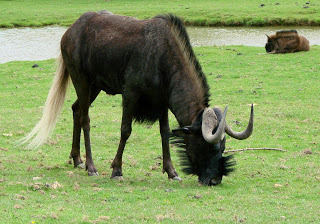 A white-tailed (aka black) gnu Connochaetes gnou, one of two antelopine 'horned horses' (public domain)
A white-tailed (aka black) gnu Connochaetes gnou, one of two antelopine 'horned horses' (public domain)
Published on October 24, 2013 18:07
October 20, 2013
TWO YETI CORPSES – MUMMIFIED BUT MISSING?
 A full-scale animatronic yeti (Dr Karl Shuker)
A full-scale animatronic yeti (Dr Karl Shuker)I’m always pleased to receive an update of an ostensibly long-forgotten cryptozoological story, especially when it’s a personal favourite of mine, like this one.
As reported by Heuvelmans, myself, and others, back in 1953 a Tibetan lama called Chemed Rigdzin Dorje Lopu announced that he had personally examined the mummified bodies of two yetis – one at the monastery at Riwoche in the Tibetan province of Kham, the other in the monastery at Sakya, southern Tibet.
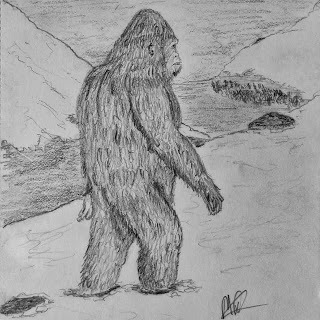 Reconstruction of the yeti (Michael Playfair)
Reconstruction of the yeti (Michael Playfair)According to Heuvelmans’s account of this lama’s very interesting claim:
They were enormous monkeys about 2.40 m high. They had thick flat skulls and their bodies were covered with dark brown hair about 3 to 5 cm long. Their tails were extremely short.
The thought that such extraordinarily significant cryptozoological relics (if genuine) may still survive today has long intrigued me. Consequently, I was delighted when on 13 February 2010 I was contacted by correspondent Peter Pesavento who informed me that he had been actively pursuing this mystery himself, and had emailed both monasteries. Unfortunately, he did not receive a reply from Sakya, but Samten O’Sullivan had very recently replied to him on behalf of Riwoche.
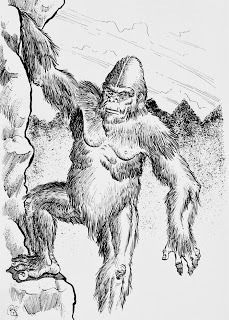 Reconstruction of the yeti (Richard Svensson)
Reconstruction of the yeti (Richard Svensson)Samten informed Peter that, tragically, the monastery had been razed to the ground following China’s annexing of Tibet and all of its precious contents had been looted or burnt. Consequently, although the monastery was subsequently rebuilt (and as an exact replica of the original), any yeti mummy that may have been in the original building is certainly not present in the new one. Whether it was removed and taken elsewhere or simply destroyed, however, is another matter, which seems unlikely ever to be resolved.
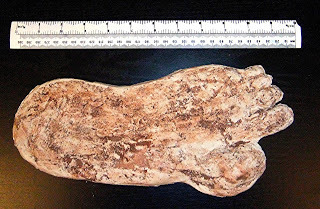 Yeti footprint cast, based upon the Shipton yeti footprint photos of 1951 (Dr Karl Shuker)
Yeti footprint cast, based upon the Shipton yeti footprint photos of 1951 (Dr Karl Shuker)Nevertheless, even knowing where something is not (namely, in the new Riwoche monastery) is still better than knowing nothing about it at all.
 Reconstruction of the yeti (Tim Morris)
Reconstruction of the yeti (Tim Morris) And if they have survived and are one day rediscovered, how fascinating it would be (judging at least from his revelation on tonight's Channel 4 television programme 'Bigfoot Files' regarding yeti hair DNA) if DNA could be extracted from them and examined by expert geneticist Prof. Bryan Sykes from Oxford University. Then at last we would finally know what these mysterious 'mega-monkey' mummies really were.
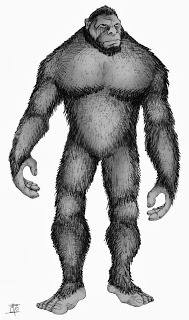 Reconstruction of the yeti (LeCire/Wikipedia, public domain)
Reconstruction of the yeti (LeCire/Wikipedia, public domain)This ShukerNature blog is excerpted from my book Karl Shuker's Alien Zoo (2010), soon to be available from CFZ Press as an e-book!
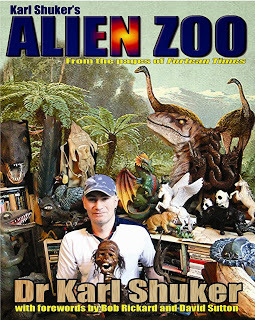
Published on October 20, 2013 14:02
Karl Shuker's Blog
- Karl Shuker's profile
- 45 followers
Karl Shuker isn't a Goodreads Author
(yet),
but they
do have a blog,
so here are some recent posts imported from
their feed.



